Permaculture companion plants for Black walnut
| Image | Name | Data | Description | Actions |
|---|---|---|---|---|
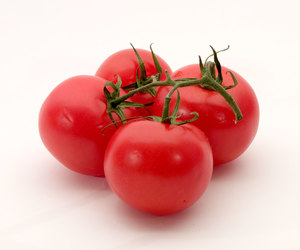
|
Tomato |
10-12
Annual, Perennial
Full sun
Moist
Light (sandy), Medium, Heavy (clay)
2.0
True
Fruit, Seed
https://en.wikipedia.org/wiki/Tomato
Fast
Garden tomato, Dumádu, Garden tomato, Love apple, Lycopersicum esculentum, Tomate, Tomato, Tomato extract containing lycopene, Tomato|thakkali, Tumatis, Lycopersicon esculentum
Solanaceae
Tomate
Oil
https://pfaf.org/User/Plant.aspx?LatinName=Solanum lycopersicum, https://pfaf.org/User/Plant.aspx?LatinName=Lycopersicon esculentum
Start seeds indoors 5-6 weeks before last frost
In containers or in rows in beds around last frost date
6.2-6.8
70-80°f
Peru
Alabama, Alaska, Andaman Is., Angola, Arizona, Arkansas, Assam, Austria, Azores, Bahamas, Bangladesh, Belarus, Benin, Bolivia, British Columbia, Bulgaria, Burkina, California, Cambodia, Cameroon, Canary Is., Cape Verde, Caroline Is., Central African Repu, Chagos Archipelago, Chatham Is., Christmas I., Colombia, Comoros, Connecticut, Cook Is., Costa Rica, Cuba, Cyprus, Czechoslovakia, Delaware, Dominican Republic, East Aegean Is., East European Russia, East Himalaya, Ecuador, Fiji, Florida, Galápagos, Georgia, Gilbert Is., Gulf of Guinea Is., Haiti, Hawaii, Illinois, India, Indiana, Iowa, Ivory Coast, Jawa, Kansas, Kazakhstan, Kentucky, Korea, Laccadive Is., Laos, Leeward Is., Line Is., Louisiana, Madagascar, Madeira, Maine, Malawi, Mali, Marianas, Marquesas, Marshall Is., Maryland, Massachusetts, Mauritania, Mauritius, Michigan, Mississippi, Missouri, Montana, Mozambique, Myanmar, Namibia, Nansei-shoto, Nauru, Nebraska, Nepal, Nevada, New Brunswick, New Caledonia, New Hampshire, New York, New Zealand North, Nicaragua, Nicobar Is., Niue, North Carolina, North Dakota, Nova Scotia, Ogasawara-shoto, Ohio, Ontario, Oregon, Pakistan, Panamá, Pennsylvania, Philippines, Pitcairn Is., Puerto Rico, Québec, Rhode I., Réunion, Saskatchewan, Selvagens, Society Is., South Carolina, South European Russi, Tadzhikistan, Taiwan, Tennessee, Texas, Trinidad-Tobago, Tuamotu, Tubuai Is., Turkey, Turkmenistan, Tuvalu, Utah, Uzbekistan, Venezuela, Vermont, Vietnam, Virginia, Wake I., Wisconsin, Zambia, Zaïre, Zimbabwe
1.00
https://powo.science.kew.org/taxon/urn:lsid:ipni.org:names:316947-2
|
The tomato is a flowering plant native to South America. It is a member of the nightshade family and closely related to the potato. The tomato plant typically grows to a height of 1-3 meters and has a weak, hairy stem. The leaves are arranged alternately on the stem and are typically dark green in color. The plant produces small yellow or white flowers, which develop into the fruit we know as tomatoes. The fruit itself is typically red, but can also be yellow, orange, green, or purple. Indeterminate tomato plants are perennials in their native habitat, but are cultivated as annuals. Determinate, or bush, plants are annuals that stop growing at a certain height and produce a crop all at once. Tomatoes prefer warm, sunny growing conditions and well-drained, humus-rich soil. They can be grown in a variety of soil types, but perform best in soil with a pH between 6 and 6.8. In order to cultivate tomatoes successfully, growers may need to provide support for the plant (such as a stake or cage) to prevent the fruit from weighing down the stem, and may also need to water and fertilize the plant regularly. Tomatoes are generally considered to be frost-sensitive, so in areas with cold winters they may need to be grown in a greenhouse or indoors. There are a great number of cultivars. The edible parts of the tomato plant are the fruit and the leaves. The fruit can be eaten raw or cooked, and is commonly used in a variety of dishes, such as salads, sandwiches, and pasta. The leaves, although not commonly eaten, are also edible and have a slightly bitter taste. After harvest, tomatoes can be stored at room temperature, in a cool place, or in the refrigerator. |
Show
Edit |
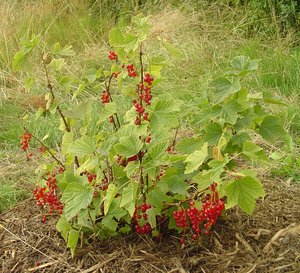
|
Red currant |
4-8
Perennial
Full sun, Partial sun/shade
Moist
Light (sandy), Medium, Heavy (clay)
Deciduous
1.2
Shrubs
Cosmetic, Dye
true
Fruit
https://en.wikipedia.org/wiki/Redcurrant
Cultivated currant
Grossulariaceae
true
https://pfaf.org/User/Plant.aspx?LatinName=Ribes rubrum
Belgium, France, Germany, Great Britain, Netherlands, Spain
Austria, Baltic States, British Columbia, Bulgaria, Central European Rus, Colorado, Connecticut, Corse, Czechoslovakia, Denmark, East European Russia, Finland, Hungary, Iceland, Illinois, Indiana, Iowa, Ireland, Italy, Japan, Kazakhstan, Korea, Krym, Labrador, Maine, Manchuria, Maryland, Massachusetts, Michigan, Minnesota, Montana, Myanmar, New Brunswick, New Hampshire, New Jersey, New York, North Carolina, Norway, Nova Scotia, Ohio, Ontario, Pennsylvania, Poland, Prince Edward I., Québec, Rhode I., Saskatchewan, South European Russi, Sweden, Switzerland, Tadzhikistan, Tennessee, Turkey, Turkey-in-Europe, Turkmenistan, Uzbekistan, Vermont, Virginia, Washington, West Virginia, Wisconsin, Wyoming, Yugoslavia
1
https://powo.science.kew.org/taxon/urn:lsid:ipni.org:names:792965-1
|
The red currant is a shrub that is native to parts of Europe and Asia. It typically grows to a height of 1-2 meters and has a bushy, upright growth habit. The leaves are simple and oval-shaped, with smooth edges and a dark green color. The flowers are small and greenish-white, growing in clusters at the ends of the branches. The fruit is a small, spherical berry that is typically red, although there are also varieties with yellow, pink, or black fruit. Red currants prefer cool, moist growing conditions and do best in well-drained, slightly acidic soil. They are winter hardy and can tolerate some frost, but may require protection in very cold climates. In general, red currants are easy to grow and do not require much special care. The edible parts of the red currant are the fruit and the leaves. The fruit can be eaten fresh or used in jams, jellies, and other preserves. The leaves can be brewed into a tea with a slightly tart flavor. The fruit and leaves can be stored in a cool, dry place after harvest. Red currants have a number of uses in the garden and landscape. The fruit is attractive to birds and other wildlife, and the shrubs can be used as a source of food and shelter for a variety of animals. The plants also have some medicinal uses, with the leaves and fruit being used in traditional remedies for a variety of conditions. Additionally, the leaves and fruit can be used as a natural dye for fabrics and other materials. |
Show
Edit |

|
Redbud |
https://en.wikipedia.org/wiki/Cercis_canadensis
true
Medium
Moist
Full sun, Partial sun/shade
4-9
Trees
Eastern redbud, mexican redbud, texas redbud
Light (sandy), Medium
Fabaceae or leguminosae
12
true
Flowers, Leaves, Seedpod
Weaving material, Lumber
Perennial
Deciduous
https://pfaf.org/User/Plant.aspx?LatinName=Cercis canadensis
Alabama, Arkansas, Connecticut, Delaware, District of Columbia, Florida, Georgia, Illinois, Indiana, Iowa, Kansas, Kentucky, Louisiana, Maryland, Massachusetts, Mexico Central, Mexico Gulf, Mexico Northeast, Michigan, Mississippi, Missouri, Nebraska, New Jersey, New Mexico, New York, North Carolina, Ohio, Oklahoma, Pennsylvania, South Carolina, Tennessee, Texas, Virginia, West Virginia, Wisconsin
Romania, Transcaucasus, Ukraine
https://powo.science.kew.org/taxon/urn:lsid:ipni.org:names:316243-2
Condiment
|
Show
Edit |
|
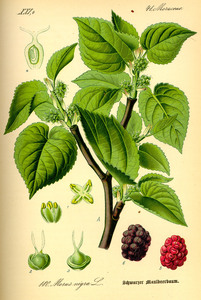
|
Black mulberry |
5-9
Full sun, Partial sun/shade
Moist
Light (sandy), Medium, Heavy (clay)
Deciduous
10.0
4.5
Perennial
Trees
Slow
Dye, Fiber, Lumber
true
Fruit, Shoots
Mulberry, Morus species
Schwarze maulbeere
Moraceae
Iran
Afghanistan, Albania, Algeria, Bermuda, Bulgaria, Canary Is., Cuba, Greece, India, Iraq, Italy, Kazakhstan, Kirgizstan, Kriti, Lebanon-Syria, Leeward Is., Libya, Madeira, Morocco, Puerto Rico, Romania, Spain, Tadzhikistan, Transcaucasus, Tunisia, Turkey, Turkmenistan, Uzbekistan, Vietnam, West Himalaya, Windward Is., Xinjiang
https://en.wikipedia.org/wiki/Morus_nigra
https://pfaf.org/User/Plant.aspx?LatinName=Morus nigra
https://powo.science.kew.org/taxon/urn:lsid:ipni.org:names:854688-1
|
The black mulberry (Morus nigra) is a species of mulberry native to southwestern Asia, including Iran, Afghanistan, and Pakistan. It is a small to medium-sized tree that grows to be about 20-30 feet tall and has a round, dense canopy. The leaves of the black mulberry are dark green and glossy on the top, and paler and slightly hairy on the bottom. The tree produces small, white flowers in the spring, which are followed by black, juicy fruits in the summer. The black mulberry is relatively fast-growing and can reach its full size in about 10-15 years. It prefers well-drained, fertile soil and full sun, but can tolerate partial shade. It is also winter hardy and can withstand temperatures down to about -10°F. The fruits of the black mulberry are edible and can be eaten fresh or used in jams, jellies, and other preserves. They can also be dried and stored for later use. The leaves of the black mulberry can be fed to silkworms, and the wood of the tree is strong and durable, making it suitable for a variety of uses. In addition to its edible fruits, the black mulberry has several other uses. Its leaves can be used as a natural fertilizer, and the tree can provide shade and wind protection in gardens and farms. The black mulberry is also a popular food source for birds and other wildlife. |
Show
Edit |
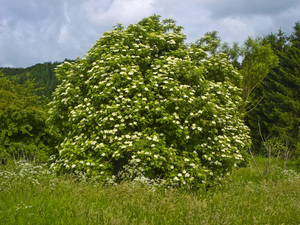
|
Black elderberry |
5-7
Full sun, Partial sun/shade
Moist
Light (sandy), Medium, Heavy (clay)
Deciduous
6
Perennial
Understory
Fast
Compost, Cosmetic, Dye, antifungal, Hedgerow, Pest control, Litmus, Microscope, Crafting, Pioneer, Poles, Lumber, Fragrance
true
Flowers, Fruit
Black elderberry, american black elderberry, blue elderberry, europea, european elder, european black elderberry
true
Caprifoliaceae
Albania, Austria, Azores, Baltic States, Belarus, Belgium, Bulgaria, Central European Rus, Corse, Czechoslovakia, Denmark, East European Russia, France, Germany, Great Britain, Greece, Hungary, Iran, Iraq, Ireland, Italy, Krym, Lebanon-Syria, Netherlands, North Caucasus, Northwest European R, Palestine, Poland, Portugal, Romania, Sardegna, Sicilia, South European Russi, Spain, Switzerland, Transcaucasus, Turkey, Turkey-in-Europe, Ukraine, Yugoslavia
Algeria, Argentina South, Bangladesh, Brazil North, Brazil Northeast, Brazil South, Brazil Southeast, Brazil West-Central, Chile Central, Chile South, Connecticut, Cyprus, East Aegean Is., Falkland Is., Finland, Kriti, Madeira, Mexico Central, Morocco, New South Wales, Norway, Ontario, Pakistan, Pennsylvania, Queensland, South Australia, Sweden, Tasmania, Tunisia, Uzbekistan, Victoria, Virginia
https://en.wikipedia.org/wiki/Sambucus_nigra
https://pfaf.org/User/Plant.aspx?LatinName=Sambucus nigra
https://powo.science.kew.org/taxon/urn:lsid:ipni.org:names:30122169-2
True
Colouring, Tea
|
Black elderberry, or Sambucus nigra, is a plant native to many parts of Europe, North America, and Asia. It is a deciduous shrub or small tree that can grow to a height of around 10-12 feet. The leaves are pinnate, with 5-9 leaflets, and the stem is often covered in a downy, greyish-white pubescence. The plant produces clusters of small, white or cream-colored flowers in the spring, which are followed by dark purple or black berries in the summer and fall. Black elderberry prefers moist, well-drained soil and full sun to partial shade, but can tolerate a range of soil types and conditions. It can be grown from seed or propagated from cuttings, but is typically propagated by root division or layering. It is winter hardy and can withstand temperatures as low as -30°F when established. The berries of the black elderberry are edible, but should not be eaten raw as they contain small amounts of toxic compounds. When cooked, however, the berries can be made into jams, jellies, syrups, and wines. The flowers can also be used to make elderflower cordial, which can be used as a refreshing beverage or to flavor desserts and baked goods. In addition to its culinary uses, black elderberry has a number of medicinal properties. The berries, flowers, and leaves have all been used to treat various ailments, including colds, flu, and other respiratory infections. The plant is also said to have anti-inflammatory and immune-boosting properties. Black elderberry is valuable to wildlife as a food source, providing a source of nutrition for birds and small mammals. The plant is also a popular nectar source for bees and other pollinators. |
Show
Edit |

|
Lycium barbarum |
6-9
Perennial
Full sun, Partial sun/shade
Moist
Light (sandy), Medium, Heavy (clay)
Deciduous
2.5
Shrubs
Hedgerow, Erosion control
true
Fruit, Leaves, Shoots
https://en.wikipedia.org/wiki/Lycium_barbarum
Medium
Goji berry, wolfberry, box thorn, matrimony vine, chinese matrimony vine, chirchitta, chirmethi, duke of argyle's teaplant, ganger, gangro, gou qi zi, kangu, khatai, kichar, kutyafa, licium, morali, ning xia gou qi, wolfberry also known as: baies de goji, baies de lycium, barberry matrimony vine, chinese boxthorn, di gu pi, épine du christ, fructus lycii, fructus lycii berry, fruit de lycium, goji chinois, goji de l’himalaya, goji juice, jus de goji, kuko, lichi, licium barbarum, litchi, lychee, lyciet, lyciet commun, lyciet de barbarie, lycii berries, lycii fruit, lycium fruit
Solanaceae
Weed potential
https://pfaf.org/User/Plant.aspx?LatinName=Lycium barbarum
China North-Central, China South-Central, Inner Mongolia, Qinghai, Xinjiang
Alabama, Albania, Alberta, Argentina South, Arkansas, Austria, Baleares, Belgium, British Columbia, Bulgaria, California, Central European Rus, Colorado, Connecticut, Corse, Czechoslovakia, Delaware, Denmark, District of Columbia, East Aegean Is., Florida, France, Georgia, Germany, Great Britain, Greece, Hungary, Idaho, Illinois, Indiana, Iowa, Ireland, Italy, Kansas, Kentucky, Korea, Kriti, Krym, Lebanon-Syria, Louisiana, Maine, Maryland, Massachusetts, Mauritius, Michigan, Minnesota, Missouri, Montana, Nebraska, Nepal, Netherlands, Nevada, New Hampshire, New Jersey, New Mexico, New South Wales, New York, North Carolina, North Dakota, Norway, Nova Scotia, Ohio, Oklahoma, Ontario, Oregon, Pennsylvania, Poland, Portugal, Queensland, Québec, Rhode I., Romania, Saskatchewan, Saudi Arabia, South Australia, South Carolina, South Dakota, South European Russi, Spain, Sweden, Switzerland, Tasmania, Tennessee, Texas, Turkey, Turkey-in-Europe, Turkmenistan, Ukraine, Utah, Uzbekistan, Vermont, Victoria, Vietnam, Virginia, Washington, West Virginia, Wisconsin, Wyoming, Yugoslavia
https://powo.science.kew.org/taxon/urn:lsid:ipni.org:names:816356-1
Tea
|
Goji (Lycium barbarum), or wolfberry (Chinese: 枸杞; pinyin: gǒuqǐ), is a flowering plant native to Asia, specifically the regions of China, Mongolia, and Tibet. It is a woody perennial that can grow up to 10 feet in height and has green leaves that are elongated and somewhat hairy. The flowers are small and white, and the fruit is a bright red, oblong berry. It's closely related to Lycium chinense, but the fruits can be distinguished by differences in taste and sugar content. In terms of growing conditions, goji plants prefer well-draining soil and full sun. They are drought-tolerant and can tolerate a wide range of temperatures, making them well-suited to many different climates. However, they do require some protection from strong winds, as their branches can be brittle and easily broken. The plant parts are called by the Latin names lycii fructus (fruit), herba lycii (leaves), etc., in modern official pharmacopeias. Goji berries are edible and are often used in traditional Chinese, Korean, Vietnamese, and Japanese medicine, since at least the 3rd century CE. They can be eaten fresh or dried, and are said to have a sweet and slightly sour taste. The berries can be stored for long periods of time, either in a cool, dry place or in the freezer. In terms of their uses, goji berries are often used in herbal remedies to boost the immune system and improve overall health. They are also said to have anti-inflammatory and antioxidant properties. The berries can also be used in cooking, either fresh or dried, and are often added to teas, smoothies, and other beverages. Goji plants are also valued for their attractiveness to wildlife, including birds and insects. The berries are a favorite food of many species, and the plants provide habitat and shelter for a variety of creatures. |
Show
Edit |

|
Sugar maple |
3-8
Perennial
Full sun, Partial sun/shade
Moist
Light (sandy), Medium, Heavy (clay)
Deciduous
30.0
Tall trees
Companion, Animal feed, Fire starter, Potash, Preservative, Lumber, Dynamic accumulator
true
Inner bark, Leaves, Sap, Seed
https://en.wikipedia.org/wiki/Acer_saccharum
Slow
Florida maple, hard maple, rock maple
Aceraceae
Zucker-ahorn
https://pfaf.org/User/Plant.aspx?LatinName=Acer saccharum
Alabama, Arkansas, Florida, Georgia, Illinois, Indiana, Iowa, Kansas, Kentucky, Louisiana, Maryland, Mexico Northeast, Michigan, Minnesota, Missouri, New York, North Carolina, Ontario, Pennsylvania, Québec, South Carolina, Tennessee, Texas, Vermont, West Virginia, Wisconsin
Korea, Poland
https://powo.science.kew.org/taxon/urn:lsid:ipni.org:names:56795-1
Sweetener
|
The sugar maple (Acer saccharum) is a deciduous tree native to the eastern and central United States and southeastern Canada. It is known for its distinctive five-lobed leaves and its production of maple syrup. In terms of appearance, the sugar maple has a rounded crown and a straight, sturdy trunk. Its leaves are typically 3-6 inches in size and have five lobes with serrated edges. The tree's flowers are small and green, and are followed by the production of winged seeds called samaras. In terms of size and growth rate, the sugar maple can grow to be quite large, reaching heights of up to 75 feet and widths of up to 50 feet. It has a moderate to fast growth rate, and can live for several hundred years. To differentiate the sugar maple from other species of maple, one can look for its distinctive five-lobed leaves and its winged seeds. Additionally, the bark of the sugar maple is smooth and gray when the tree is young, but becomes dark and deeply furrowed as the tree matures. In terms of growing conditions, the sugar maple prefers well-drained, moist soil and partial to full sunlight. It is adaptable to a range of soil types, but prefers slightly acidic soil. To cultivate the sugar maple successfully, a grower may need to provide regular watering and mulching, as well as protection from strong winds. The sugar maple is winter hardy and can withstand cold temperatures. The sugar maple is edible, and its sap can be collected and boiled down to produce maple syrup. The tree's leaves, seeds, and bark can also be used for medicinal purposes. In terms of its value for wildlife, the sugar maple provides food and shelter for a variety of species. Its seeds are eaten by birds and small mammals, and its leaves provide food for caterpillars. The tree's sturdy branches provide perches for birds and its dense canopy offers protection from the elements. |
Show
Edit |
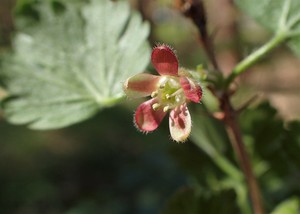
|
Gooseberry |
4-8
Perennial
Full sun, Partial sun/shade
Moist
Light (sandy), Medium, Heavy (clay)
Deciduous
1.2
Shrubs
Cosmetic
true
Fruit, Leaves
https://en.wikipedia.org/wiki/Ribes_uva-crispa
Medium
European gooseberry, american gooseberry, cu li, egres, fuge, gigadze, groseille a maquareau, groseillier, grosella blanca, grosellero, kikerberi, kryhovnik, maru suguri, stachelbeere, uva spina
Grossulariaceae
true
https://pfaf.org/User/Plant.aspx?LatinName=Ribes uva-crispa
Albania, Algeria, Austria, Belgium, Bulgaria, Czechoslovakia, France, Germany, Greece, Hungary, Iran, Italy, Kriti, Morocco, Netherlands, Poland, Romania, Spain, Switzerland, Transcaucasus, Turkey, Ukraine, Yugoslavia
Baltic States, Belarus, Central European Rus, China North-Central, Connecticut, Delaware, Denmark, East European Russia, Falkland Is., Finland, Great Britain, Iceland, Indiana, Iowa, Ireland, Japan, Kentucky, Korea, Kuril Is., Labrador, Maine, Manchuria, Maryland, Massachusetts, New Hampshire, New Jersey, New York, Newfoundland, North Dakota, North European Russi, Ohio, Ontario, Pennsylvania, Québec, South Dakota, South European Russi, Sweden, Tadzhikistan, Turkey-in-Europe, Vermont, West Virginia, Wisconsin, Xinjiang
https://powo.science.kew.org/taxon/urn:lsid:ipni.org:names:793052-1
1
|
The gooseberry is a plant native to Europe, northern Africa, and western Asia. It is a shrub that typically grows to 1-2 meters in height, with spiny stems and green leaves that are oval in shape. The plant produces small green or red berries that are edible. The gooseberry plant prefers to grow in full sun and well-draining soil. It can tolerate a variety of soil types but prefers a neutral to slightly acidic pH. Growers may need to prune the plant regularly to maintain its shape and encourage fruit production. The plant is winter hardy, meaning it can withstand cold temperatures without damage. The berries of the gooseberry plant are edible and can be eaten fresh or used in cooking. They are high in vitamin C and can be stored in the refrigerator for several days after harvest. The plant has a number of uses, including medicinal uses such as treating diarrhea and dysentery. The plant's leaves can also be used as a natural insect repellent. In addition to its uses for humans, the gooseberry plant is also valuable for wildlife. The plant provides food and shelter for a variety of animals, including birds, insects, and small mammals. The plant's spiny stems also provide protection for nesting birds. Overall, the gooseberry is a versatile and valuable plant for gardeners and farmers. |
Show
Edit |

|
Black raspberry |
https://en.wikipedia.org/wiki/Rubus_occidentalis
true
Moist
Full sun, Partial sun/shade
3-7
Shrubs
Light (sandy), Medium, Heavy (clay)
Rosaceae
3.0
Schwarze himbeere
Tea
Fruit, Shoots, Stem
Dye
Perennial
Deciduous
https://pfaf.org/User/Plant.aspx?LatinName=Rubus occidentalis
Alabama, Arkansas, Connecticut, Delaware, District of Columbia, Georgia, Illinois, Indiana, Iowa, Kansas, Kentucky, Maine, Maryland, Massachusetts, Michigan, Minnesota, Mississippi, Missouri, Nebraska, New Brunswick, New Hampshire, New Jersey, New York, North Carolina, North Dakota, Ohio, Oklahoma, Ontario, Pennsylvania, Québec, Rhode I., South Carolina, South Dakota, Tennessee, Vermont, Virginia, West Virginia, Wisconsin
Central European Rus, Colorado, Czechoslovakia, Poland
https://powo.science.kew.org/taxon/urn:lsid:ipni.org:names:223350-2
|
Show
Edit |
|

|
Honey locust |
3-9
Full sun
Dry, Moist
Light (sandy), Medium, Heavy (clay)
Deciduous
20.0
17
Perennial
Tall trees
Medium
Animal feed, Gum, Soil reclamation, Tannin, Lumber, Fragrance
true
Seed, Seedpod
Amerikanische gleditschie
Fabaceae or leguminosae
Alabama, Arkansas, Connecticut, Delaware, Florida, Georgia, Illinois, Indiana, Iowa, Kansas, Kentucky, Louisiana, Maine, Maryland, Massachusetts, Mexico Northeast, Mexico Northwest, Michigan, Minnesota, Mississippi, Missouri, Nebraska, Nevada, New Hampshire, New Jersey, New York, North Carolina, North Dakota, Ohio, Oklahoma, Pennsylvania, Rhode I., South Carolina, South Dakota, Tennessee, Texas, Utah, Vermont, Virginia, West Virginia, Wisconsin, Wyoming
Argentina Northeast, Argentina Northwest, Austria, Baltic States, Belarus, Bulgaria, Cape Provinces, Central European Rus, China Southeast, Colorado, Czechoslovakia, France, Free State, Germany, Hungary, India, Iraq, Italy, Kazakhstan, Kirgizstan, Krym, KwaZulu-Natal, Lesotho, Mexico Southwest, Mozambique, New Mexico, New South Wales, North Caucasus, Northern Provinces, Pakistan, Portugal, Queensland, Romania, Saudi Arabia, South Australia, South European Russi, Spain, Tadzhikistan, Transcaucasus, Turkmenistan, Uganda, Ukraine, Uruguay, Uzbekistan, Victoria, West Himalaya, Zimbabwe
https://en.wikipedia.org/wiki/Honey_locust
https://pfaf.org/User/Plant.aspx?LatinName=Gleditsia triacanthos
https://powo.science.kew.org/taxon/urn:lsid:ipni.org:names:110723-2
168.6
Weed potential
Coffee, Drink, Gum, Sweetener
|
Show
Edit |
|

|
Black locust |
4-9
Perennial
Full sun
Dry, Moist
Light (sandy), Medium, Heavy (clay)
25.0
Trees
Dye, Essential Oil, Fiber, Animal feed, Fire starter, oil, Erosion control, Lumber, Dynamic accumulator, Nitrogen fixer, Fragrance
true
Flowers, Seed, Seedpod
https://en.wikipedia.org/wiki/Robinia_pseudoacacia
Fast
Yellow locust
Fabaceae or leguminosae
Gewöhnliche robinie
Oil, Condiment, Drink
Weed potential
https://pfaf.org/User/Plant.aspx?LatinName=Robinia pseudoacacia
19.2
Alabama, Georgia, Illinois, Kentucky, Maryland, Pennsylvania, Tennessee, Vermont
Albania, Algeria, Argentina Northeast, Austria, Azores, Baltic States, Belarus, Belgium, Bulgaria, California, Canary Is., Cape Provinces, Central European Rus, Chile Central, China North-Central, China South-Central, China Southeast, Colorado, Czechoslovakia, East Aegean Is., East European Russia, Easter Is., France, Free State, Germany, Great Britain, Greece, Hungary, Idaho, India, Inner Mongolia, Iraq, Italy, Japan, Kazakhstan, Khabarovsk, Kirgizstan, Korea, Kriti, Krym, Kuril Is., KwaZulu-Natal, Lebanon-Syria, Lesotho, Libya, Madeira, Manchuria, Mexico Northwest, Minnesota, Morocco, Netherlands, Nevada, New Mexico, New York, New Zealand North, New Zealand South, North Caucasus, Northern Provinces, Oregon, Pakistan, Palestine, Poland, Primorye, Qinghai, Romania, Réunion, Sakhalin, Sardegna, Sicilia, South European Russi, Spain, Switzerland, Tadzhikistan, Taiwan, Texas, Transcaucasus, Turkey, Turkey-in-Europe, Turkmenistan, Ukraine, Uzbekistan, Washington, West Himalaya, Wisconsin, Xinjiang, Yugoslavia
3
https://powo.science.kew.org/taxon/urn:lsid:ipni.org:names:30034699-2
|
Black locust (Robinia pseudoacacia) is a fast-growing tree that is native to the eastern United States. It is a member of the pea family, Fabaceae, and is known for its fragrant, white flowers and dark, hardwood timber. Black locust trees can grow to a height of 80-100 feet and have a straight, upright growth habit. The bark is dark and furrowed, and the leaves are compound, with 7-19 oval-shaped leaflets arranged along a central stem. The flowers are fragrant and bloom in clusters in the spring, and are followed by long, slender seed pods that contain small, brown seeds. To grow black locust successfully, it is important to choose a location with well-drained, fertile soil and full sun. The tree is adaptable and can grow in a variety of soil types, but prefers moist conditions and does not tolerate drought well. Black locust can also be grown in containers, but will need to be repotted regularly to accommodate its rapid growth. Black locust wood is strong and durable, and is often used for fence posts, poles, and other construction purposes. The bark, leaves, and flowers can also be used for a variety of purposes. The bark can be used to make a yellow dye, and the leaves and flowers can be used as a natural insect repellent. The flowers are also edible, and can be used to make a sweet, fragrant tea. Black locust is also a valuable food source for wildlife, including birds, deer, and small mammals. The flowers attract bees and other pollinators, and the seeds are eaten by birds and other animals. It is important to note that, while black locust is generally safe to handle and consume, the plant contains toxic compounds that can cause irritation and allergic reactions in some people. Additionally, black locust is considered invasive in some areas, and can spread rapidly if not controlled. |
Show
Edit |

|
Parsley |
5-8
Biennial
Full sun, Partial sun/shade
Moist
Light (sandy), Medium, Heavy (clay)
0.6
Herbs
true
Leaves
https://en.wikipedia.org/wiki/Parsley
Medium
Apiaceae or umbelliferae
Petersilie
https://pfaf.org/User/Plant.aspx?LatinName=Petroselinum crispum
Algeria
Greece, Morocco, Yugoslavia
15cm
https://powo.science.kew.org/taxon/urn:lsid:ipni.org:names:60442790-2
Colouring, Tea
Essential Oil, Hair, Dynamic accumulator, Fragrance
|
Parsley is a herb native to the central and eastern Mediterranean region. It has bi-pinnate leaves and small, white or green flowers. The plant grows to a height of about 30 cm and has a fast growth rate. It can be differentiated from similar plants by its bi-pinnate leaves and small, white or green flowers. Parsley prefers well-drained soil and full sun to partial shade. To cultivate it successfully, a grower may need to water it regularly and protect it from frost. The plant is winter hardy and can withstand cold temperatures. Parsley is edible and its leaves and stems can be used in cooking. The edible parts can be stored after harvest by drying or freezing. Parsley has many uses, including medicinal and culinary. It has been used to treat a variety of ailments, such as indigestion and inflammation. In the kitchen, it can be used as a garnish or added to dishes for flavor. Parsley is also a good source of vitamins and minerals, such as vitamins A and C and iron. Parsley is valuable for wildlife as it provides nectar for pollinators. It is also a good source of food for some animals, such as rabbits and deer. #### Links [Parsley @ Wikipedia](https://en.wikipedia.org/wiki/Parsley) |
Show
Edit |
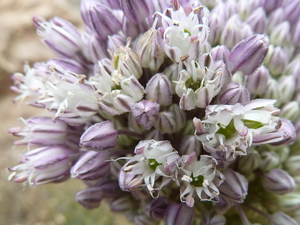
|
Allium ampeloprasum |
5-9
Full sun
Dry, Moist
Light (sandy), Medium, Heavy (clay)
1.8
0.3
Herbs
true
Flowers, Leaves, Root
Broadleaf wild leek
Lauch
Alliaceae
Albania, Algeria, Baleares, Bulgaria, Cyprus, East Aegean Is., Egypt, Ethiopia, France, Greece, Iran, Iraq, Italy, Kriti, Lebanon-Syria, Libya, Morocco, Palestine, Portugal, Romania, Sardegna, Sicilia, Sinai, Spain, Transcaucasus, Tunisia, Turkey, Turkey-in-Europe, Turkmenistan, Uzbekistan, Yugoslavia
Alabama, Argentina Northeast, Azores, Baltic States, Belarus, California, Canary Is., Central European Rus, Cuba, Czechoslovakia, Dominican Republic, East European Russia, Galápagos, Great Britain, Haiti, Illinois, Ireland, Kentucky, Madeira, Mexico Central, Mexico Northeast, Mexico Northwest, Mexico Southeast, Mexico Southwest, New South Wales, New York, North European Russi, Northwest European R, Pakistan, Puerto Rico, South Australia, South European Russi, Tasmania, Tennessee, Texas, Ukraine, Victoria, Western Australia
https://en.wikipedia.org/wiki/Allium_ampeloprasum
https://pfaf.org/User/Plant.aspx?LatinName=Allium ampeloprasum
https://powo.science.kew.org/taxon/urn:lsid:ipni.org:names:332079-2
|
Show
Edit |
|

|
Pedunculate Oak |
4-8
Perennial
Full sun, Partial sun/shade
Moist, Wet
Medium, Heavy (clay)
Evergreen
30.0
Tall trees
Weaving material, Fire starter, Compost, Gum, Ink, Tannin, Lumber
true
Seed
https://en.wikipedia.org/wiki/Quercus_robur
Slow
English oak
Fagaceae
https://pfaf.org/User/Plant.aspx?LatinName=Quercus robur
Eiche
Albania, Altay, Austria, Baltic States, Belarus, Belgium, Bulgaria, Central European Rus, Corse, Czechoslovakia, Denmark, East European Russia, Finland, France, Germany, Great Britain, Greece, Hungary, Iran, Ireland, Italy, Kriti, Krym, Netherlands, North Caucasus, North European Russi, Northwest European R, Norway, Poland, Portugal, Romania, Sardegna, Sicilia, South European Russi, Spain, Sweden, Switzerland, Transcaucasus, Turkey, Turkey-in-Europe, Ukraine, Yugoslavia
British Columbia, Canary Is., Cape Provinces, Colorado, Free State, Kentucky, KwaZulu-Natal, Lesotho, Madeira, New Brunswick, New York, New Zealand North, New Zealand South, Nova Scotia, Prince Edward I., Réunion, St.Helena
https://powo.science.kew.org/taxon/urn:lsid:ipni.org:names:304293-2
Coffee, Gum
|
The pedunculate oak, also known as Quercus robur, is a type of tree that is native to Europe, Asia, and North Africa. It is a large tree that can grow to be up to 80 feet tall, with a trunk that can reach up to 4 feet in diameter. The leaves of the pedunculate oak are dark green and lobed, with a leathery texture. The tree produces small, pale green flowers that bloom in the spring, followed by acorns in the fall. The pedunculate oak prefers to grow in full sun and well-drained soil. It is a slow-growing tree, but it can live for hundreds of years. To cultivate the tree successfully, a grower should plant it in an area that receives plenty of sunlight and water it regularly during the first few years of growth. The tree is winter hardy and can withstand cold temperatures. The leaves, acorns, and bark of the pedunculate oak are all edible. The leaves can be used in salads, while the acorns can be ground into a flour and used to make bread or other baked goods. The bark can be used to make tea. After harvest, the edible parts of the tree can be stored in a cool, dry place. The pedunculate oak has many uses. It is often used as a source of wood for construction and furniture-making, and its leaves and acorns are used as food for livestock. The tree can also provide habitat and food for a variety of wildlife, including birds, squirrels, and deer. The bark of the pedunculate oak has been used medicinally in the past to treat a variety of ailments, including diarrhea, wounds, and fevers. |
Show
Edit |
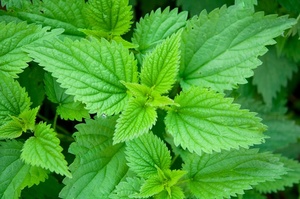
|
Urtica dioica |
3-10
Perennial
Full sun, Partial sun/shade
Moist
Light (sandy), Medium, Heavy (clay)
1.2
Herbs
true
Leaves, Shoots
https://en.wikipedia.org/wiki/Urtica_dioica
Fast
California nettle, achoka, bichhu booti, bichhua, bichua, chichru, irhawurhawu, kopriva, korvenoges, krapiva, noges, patle sishnu, pokrzywa, polo, raudnoges, sishnu, sisnu, tall nettle, zara, zastisod, zocha, american stinging nettle, brandnetelwortel, brennessel, brennesselblätter, brennesselwurzel, brennnesselwurzel, brännässelrot, brännässla, brännässleblad, brændenælderod, california nettle, chalkan, chayan oot, chhoku, chichicaste, chule, chutle, common nettle, common stinging nettle for homoeopathic preparations, csalángyökér, csalánlevé, dhyo, european nettle, european stinging nettle, folia urticae, gazanda, gazaneh, gazgazuk, giant nettle, grande ortie, great nettle, greater nettle, grosse brennessel, große brennessel, gherq il-hurrieq, haarnesselwurzel, hanfnesselwurzel, hhurrayq, horeig, hyo, jhaduk, kajyang, kichitki oot, kopriva, koprivový koren, korenina koprive, korzen pokrzywy, krapiva dvudomnaya, nelau, neslerot, nesselwurzel, nettle, nettle herb, nettle leaf, nettle root, nettle stinging, nhyakan, nokkonen, juuri, nõgesejuur, natru saknes, ortica, ortica maschio, ortica radice, ortie, ortie (feuille d’), ortie (racine d'), ortie brulante, ortie dioïque, ortiga, ortiga mayor, hoja, raíz de, pokrzywa, polo, pulu, prhlavový koren, qurrays, racine d'ortie, radix urticae, raiz de ortiga, radacina de urzica, satu, sikya, sisna, sisnu, slender nettle, stinging nettle, stinging nettle herb, syak, tall nettle, tsuknida, urtica dioica, urtica dioica ad praeparationes homoeopathicas, urticae folium, urticae herba, urticae radix, urtiga, raiz, urtiga-maior, urtiga-mansa, urtiga-vermelha, urtigão, yi zhu qian ma, za-chhag, zwa, zwyczajna, isirgan
Urticaceae
Brennnessel
Oil, Colouring, Curdling agent, Drink
Weed potential
https://pfaf.org/User/Plant.aspx?LatinName=Urtica dioica
Afghanistan, Albania, Algeria, Altay, Amur, Assam, Austria, Baltic States, Belarus, Belgium, Bulgaria, Buryatiya, Central European Rus, China North-Central, China South-Central, Chita, Corse, Czechoslovakia, Denmark, East Aegean Is., East European Russia, East Himalaya, Finland, France, Føroyar, Germany, Great Britain, Greece, Hungary, Iceland, India, Inner Mongolia, Iran, Iraq, Ireland, Irkutsk, Italy, Japan, Kamchatka, Kazakhstan, Khabarovsk, Kirgizstan, Korea, Krasnoyarsk, Kriti, Krym, Lebanon-Syria, Magadan, Manchuria, Mongolia, Morocco, Nepal, Netherlands, North Caucasus, North European Russi, Northwest European R, Norway, Pakistan, Poland, Portugal, Primorye, Qinghai, Romania, Sakhalin, Sardegna, Sicilia, South European Russi, Spain, Sweden, Switzerland, Tadzhikistan, Tibet, Transcaucasus, Tunisia, Turkey, Turkey-in-Europe, Turkmenistan, Tuva, Ukraine, Uzbekistan, West Himalaya, West Siberia, Xinjiang, Yakutskiya, Yugoslavia
Alabama, Alaska, Argentina Northeast, Bolivia, Brazil Northeast, Brazil South, Brazil Southeast, British Columbia, California, Cape Provinces, Chile Central, Chile South, Colombia, Connecticut, Delaware, District of Columbia, Ecuador, Eritrea, Falkland Is., Florida, Georgia, Greenland, Guatemala, Libya, Maine, Maryland, Massachusetts, Michigan, Missouri, New Brunswick, New Hampshire, New Jersey, New York, New Zealand North, New Zealand South, Newfoundland, North Carolina, Nova Scotia, Ohio, Oklahoma, Ontario, Oregon, Pennsylvania, Prince Edward I., Québec, Svalbard, Tennessee, Tristan da Cunha, Virginia, Washington, West Virginia
https://powo.science.kew.org/taxon/urn:lsid:ipni.org:names:260630-2
Biomass, Compost, Dye, Fiber, Hair, Animal feed, oil, Waterproofing, Dynamic accumulator
|
Stinging nettle (Urtica dioica) is a perennial plant that is native to many parts of Europe, Asia, and North America. It is found in a variety of habitats, including damp forests, stream banks, and meadows. Stinging nettle has green, heart-shaped leaves that are arranged opposite each other on the stem. The leaves and stems are covered with tiny, hollow hairs that can inject a painful, stinging sensation when they come into contact with skin. The plant also produces small, greenish-white flowers that grow in clusters. Stinging nettle can grow to be quite tall, sometimes reaching heights of up to six feet. It grows quickly and can spread rapidly. To cultivate stinging nettle, it is best to start with rooted cuttings or small plants. The plant prefers moist, well-draining soil and partial shade, but it can also grow in full sun. It is important to keep the soil consistently moist, especially during the plant's first growing season. Stinging nettle is edible, but the leaves and stems must be cooked or dried to remove the stinging hairs. The leaves can be used in a variety of dishes, including soups, stews, and teas. They can also be dried and stored for later use. The roots can also be eaten, but they are more difficult to harvest and prepare. Stinging nettle has a number of uses, both medicinal and practical. The leaves and stems can be used to make a tea that is rich in vitamins and minerals, and has been used to treat a variety of conditions, including arthritis, eczema, and gout. The plant can also be used as a natural fertilizer, thanks to its high nitrogen content. In addition, the leaves can be used as mulch, and the fibers from the stems can be used to make ropes and cloth. Stinging nettle is also valuable for wildlife, providing food and habitat for a variety of animals. The leaves are a source of food for many species of butterflies and moths, and the plant also provides shelter for small mammals and birds. Overall, stinging nettle is a versatile and useful plant that has a variety of applications for gardeners, farmers, and herbalists. Despite its painful sting, it is a valuable addition to any garden or landscape. |
Show
Edit |
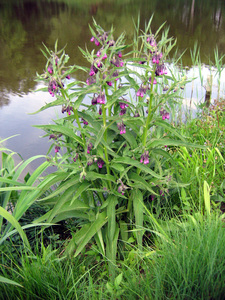
|
Comfrey |
3-9
Perennial
Full sun, Partial sun/shade
Moist
Light (sandy), Medium, Heavy (clay)
1.2
Herbs
true
Leaves, Shoots
https://en.wikipedia.org/wiki/Symphytum_officinale
Fast
Common comfrey, Comfrey, Symphytum
Boraginaceae
https://pfaf.org/User/Plant.aspx?LatinName=Symphytum officinale
Gewone smeerwortel
Lægekulsukker
Altay, Austria, Belarus, Belgium, Bulgaria, Central European Rus, Czechoslovakia, East European Russia, France, Germany, Great Britain, Hungary, Italy, Kazakhstan, Krym, Netherlands, North Caucasus, Northwest European R, Poland, Romania, Sardegna, Sicilia, South European Russi, Spain, Switzerland, Turkey, Turkey-in-Europe, Ukraine, West Siberia, Yugoslavia
Alberta, Argentina Northeast, Arkansas, Baltic States, Brazil West-Central, British Columbia, California, China North-Central, China Southeast, Chita, Colorado, Connecticut, Delaware, Denmark, District of Columbia, Dominican Republic, Finland, Georgia, Haiti, Idaho, Illinois, Indiana, Ireland, Kentucky, Korea, Maine, Manchuria, Manitoba, Maryland, Massachusetts, Michigan, Minnesota, Missouri, Montana, New Brunswick, New Hampshire, New Jersey, New Mexico, New York, Newfoundland, North Carolina, North European Russi, Norway, Nova Scotia, Ohio, Ontario, Oregon, Pennsylvania, Primorye, Québec, Rhode I., Saskatchewan, Sweden, Taiwan, Tasmania, Utah, Vermont, Vietnam, Virginia, Washington, West Virginia, Wisconsin, Wyoming, Xinjiang
Beinwell, Wallwurz, Beinwurz
60cm
https://powo.science.kew.org/taxon/urn:lsid:ipni.org:names:120815-1
Gum, Tea
Biomass, Compost, Gum, Dynamic accumulator
|
Comfrey (Symphytum officinale) is a perennial plant that is native to Europe and Asia. It belongs to the family Boraginaceae, which includes around 300 species of plants. Comfrey is a popular garden plant, known for its large, hairy leaves and bell-shaped, white or purple flowers. The plant has a sprawling growth habit and can reach a height of up to 3-4 feet. The leaves are large, oval-shaped, and covered in fine hairs, and the flowers are clustered in elongated spikes at the ends of the stems. To grow comfrey successfully, it is important to choose a location with well-drained, fertile soil and full sun or partial shade. The plant is tolerant of a wide range of soil conditions, but prefers moist, slightly acidic soil. Comfrey can also be grown in containers, and will benefit from regular watering and fertilization. The plant is relatively easy to grow and requires little maintenance, but can be susceptible to pests and diseases, such as slugs and fungal infections. Comfrey is not edible, and the leaves and roots of the plant contain toxic compounds that can cause irritation and allergic reactions in some people. However, the plant has a number of other uses, including medicinal and horticultural applications. The leaves and roots of the plant are high in nutrients, and are often used as a natural fertilizer for plants. The leaves can also be used to make a medicinal tea, and have been used to treat a variety of ailments, including wounds, bruises, and respiratory disorders. Comfrey is also a valuable food source for many types of wildlife, including bees, butterflies, and other pollinators. The flowers attract a wide range of insects, and the leaves and roots are eaten by animals such as rabbits and deer. The plant can spread rapidly and is considered invasive in some areas. |
Show
Edit |